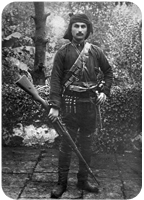Giresun Castle may be analysed as internal and external castle sections. Palace ruins exist at the inner castle on the hill dominating the city. Aristotales, in his work called “Neofitos” (Giresun City) describes the castle as one that is high walled, is defensively superior and is hard to be captured. The rampart which begins from the Southwest, enclosing the city, stretches to the Northeast. A section of the walls built of great rough stones are restored by the Ministry of Culture. According to the writings of Neofitos, a little horse relievo exists on the rocks west of the hill. It is said to be on Ayios Ilyos’ grave. It is stated in the Byzantine writing seen on the lower rocks that here is a small church. There are huge cave refuges in the North of the castle.
Hero of the War of Independence
 |
He was born in the Hacı Hüseyin District on 1884. He was injured from his right kneecap while fighting against Bulgarians in the Balkan War in the Çatalca Front. He received treatment in the Şişli Etfal Hospital. He stopped Enver Paşa from entering Anatolia in the Independence War. When the bullets of the Giresun Voluntary Legion under his command ran out in the Sakarya War, he attacked the enemy with his daggers. He took role in the quashing of the Koçgiri Revolt. The grave of Gazi Osman Ağa (Lame Osman Ağa), who showed great merit and acted as Atatürk’s guard commander in the Independence War, is in the castle. |
|

